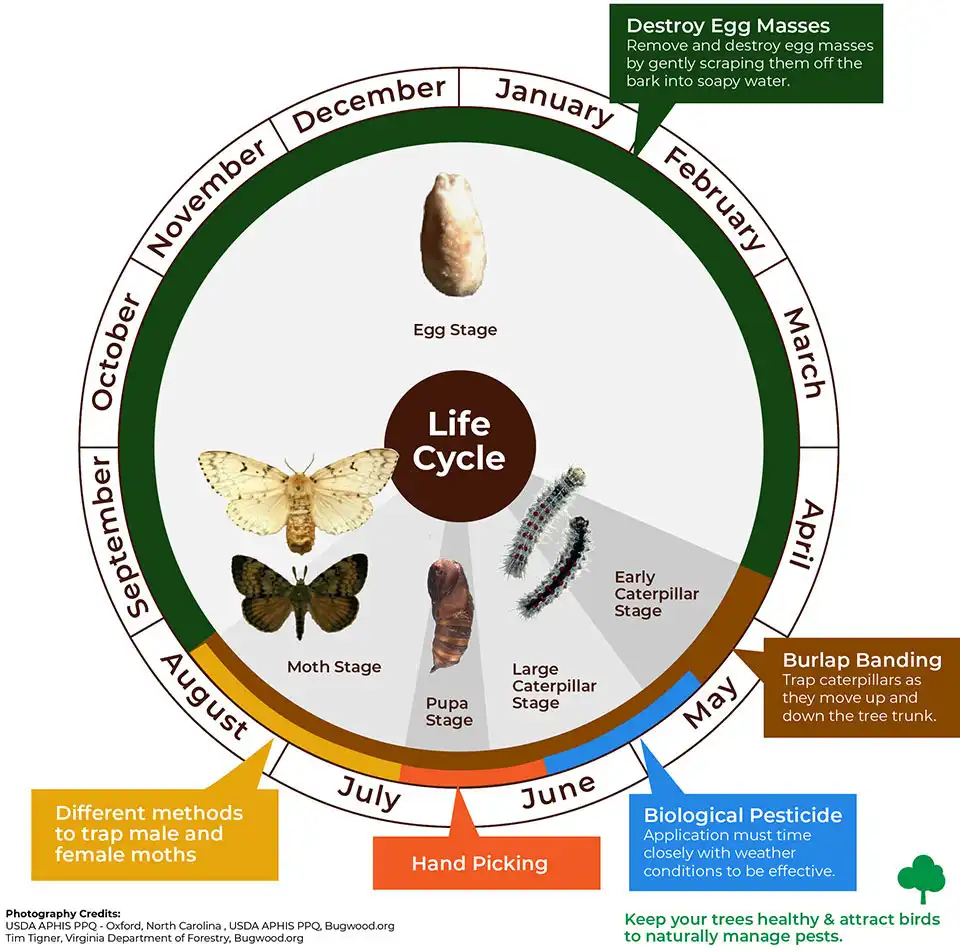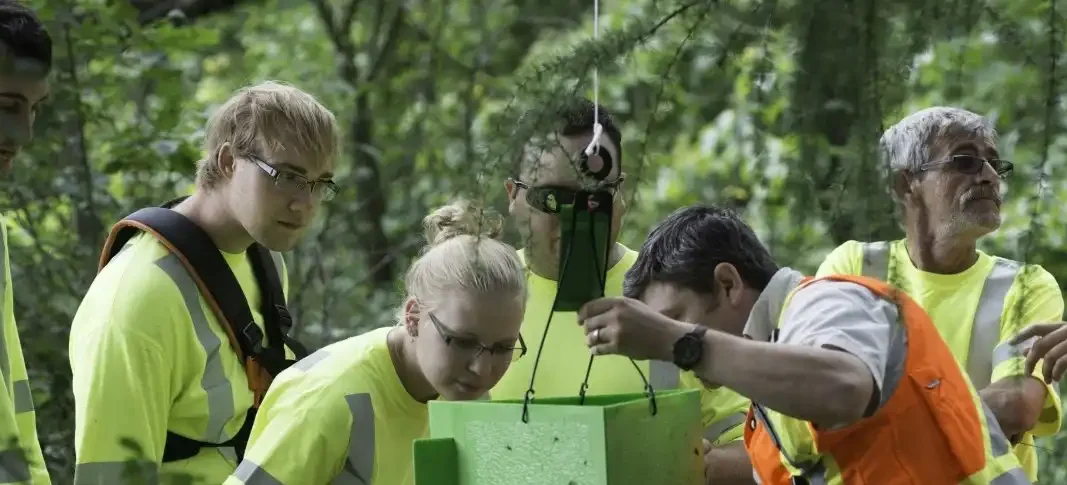
Invasive Species
Invasive Species are organisms (plant, animal, fungus or bacterium) that are not native to a region and have negative effects its economy, environment or public health. Emerald Ash Borer (EAB) and LDD Moth are two invasive species found in Northumberland County.
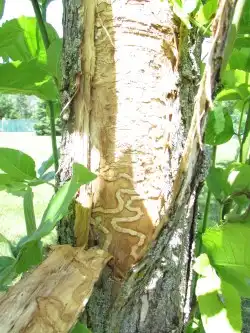
Emerald Ash Borer
The EAB is an invasive insect that bores holes in ash trees and kills them within two years. The larvae feed on the inner bark of the tree, removing the bark and disrupting the flow of nutrients. This results in the death of the tree by girdling.
EAB was first located in Michigan in 2002. It has now spread throughout Ontario, Quebec and the eastern United States. The insect can travel short distances through flight but primarily moves through human assistance (firewood, nursery stock and wood products).
Frequently Asked Questions
Northumberland County is responsible for treating or removing and replacing ash trees located on County roads and other County-owned properties. Infected trees pose a hazard of falling due to weakened, damaged bark.
In 2016, the County inventoried all ash trees along County roads and on County properties.
In November 2018, the County hosted a public information session about the 10-year hazard-removal, replacement and tree diversification plan in response to the presence of Emerald Ash Borer (EAB) in Northumberland.
In January 2019, scheduled removal began of ash trees located along County roads that are above 10 cm in diameter.
Tree removal is planned for all seven municipalities in Northumberland County over the next 10 years. Please review our map, which outlines the number of ash trees to be removed by section of road.
Downed Ash trees will be replaced with a variety of tree species native to this area to minimize climate- and invasive species-related risks to the overall tree population. Funding will subsidize 60,000 saplings—12,000 annually—or roughly 10 replacement trees for every one tree being removed.
Property owners are responsible for maintaining, treating and removing ash trees (and any other trees) located on their property. Dead and dying trees are hazardous and must be removed.
Ask a professional arborist for:
- Proof of liability insurance
- Proof of WSIB
- Certification in good standing with the International Society of Arboriculture
If you choose to treat your ash tree with insecticide, ask for a pesticide applicators license.
Before removing your tree, check to see if your municipality has a tree by-law in place.
Frequently Asked Questions
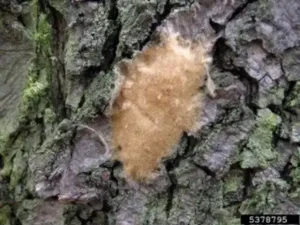 Stage 1 – Egg masses
Stage 1 – Egg masses
Egg masses are about 4 cm, tan-coloured, and can be found on any hard surface – including tree trunks, furniture, and buildings.
Photo credit: Milan Zubrik, Forest Research Institute – Slovakia, Bugwood website
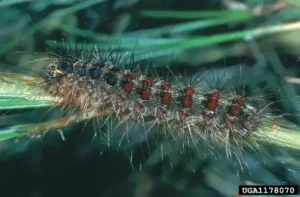 Stage 2 – Caterpillars
Stage 2 – Caterpillars
Caterpillars are 5-6 cm long and have 5 pairs of blue dots and 6 pairs of red dots along their backs.
Photo credit: Connecticut Agricultural Experiment Station, Connecticut Agricultural Experiment Station, Bugwood website
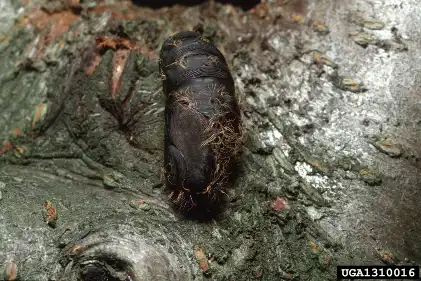 Stage 3 – Pupa
Stage 3 – Pupa
Pupa are 3 cm long, brown with small white/yellow sparse hairs, and can be found in cracks of trees and building overhangs.
Photo credit: Jim Occi, BugPics, Bugwood website
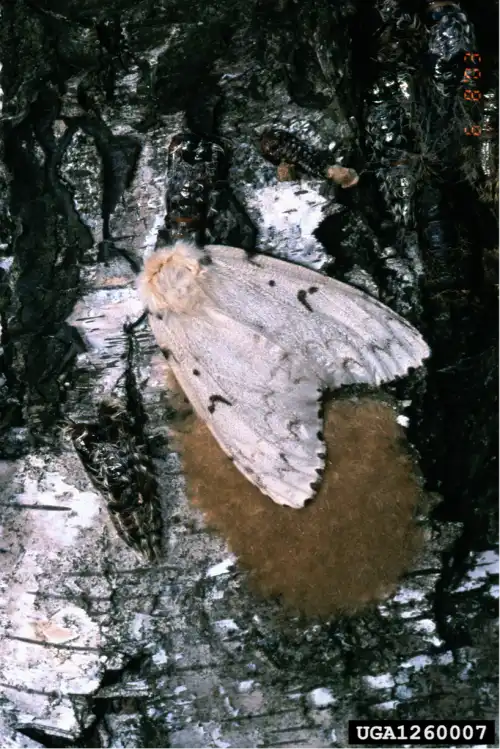 Stage 4 – Adult moths
Stage 4 – Adult moths
Adult moths can be white with dark markings (females, 5 cm wingspan) or brown with dark markings (males, 2.5 cm wingspan).
Photo credit: Hannes Lemme, Bavarian State Research Center for Agriculture, Bugwood website
Spongy Moth caterpillars defoliate leaves of host trees, mostly hardwood species, such as oak, birch, poplar, willow, maple and others.
Property owners are responsible for managing trees and pests on their property.
Tree damage from Spongy Moth depends on the degree of infestation, past defoliations, the tree’s vulnerability and the environment. Damage levels can range from light to almost complete defoliation. Healthy trees often recover from defoliation, however drought or disease-stressed trees can be further weakened and potentially die. Severe defoliation of coniferous trees may result in mortality after just one season. Maintaining healthy trees and forests is an important defence against Spongy Moth.
Help stop the spread of Spongy Moth by making sure not to move firewood.
Removing egg masses
Egg masses can be removed from trees in fall and winter by soaking the eggs in a soap and water mixture. Simply wear gloves, scrape off the eggs, then put them in a bucket of soapy water for about two days. Discard the eggs in your regular garbage receptacle.
Removing caterpillars
A band of burlap or other cloth product wrapped around the trunk will provide a place for caterpillars to hide during the heat of the day and makes it easy to collect and discard of caterpillars.
- Make sure your burlap is long enough to wrap around the entire trunk of the tree.
- Use twine or rope to tie the burlap to the tree, near the middle of the trunk.
- Fold the top of the burlap down over the rope or twine. This fold is like a little apron for the caterpillars to crawl into. They don’t like being in full sunlight, so they’ll instinctively go somewhere that protects them from the heat.
- Every day, check the band for caterpillars. Wear gloves since they can irritate the skin.
- As with the eggs, drop them into a bucket of soapy water and leave for two days. Then throw the carcasses in the garbage.
Repeat this process until your trees are free of caterpillars and/or pupae.
Outbreaks of this species are cyclical with population surges approximately every 7-10 years. Outbreaks are caused by biological and environmental factors such as warm winters and dryness in spring. Naturally occurring viral and fungal pathogens will control populations and collapse the population back to low densities within 1-3 years of outbreak.
Northumberland County is taking an Integrated Pest Management (IPM) approach. This means we are using different effective and environmentally sound management techniques to address the pest population, starting with the least invasive options.
Surveys were completed in fall 2020 and 2021 to assess the population and forecast future impacts of Spongy Moth. Further monitoring is planned for 2022. It is anticipated that some areas within the County will see moderate to severe defoliation in 2022.
County staff have also been removing egg masses from the Northumberland County Forest in Special Management Zones to help protect areas with high conservation values.
At the April 5, 2022 meeting of the Northumberland County Corporate Services Committee, Forest staff delivered an update on Spongy Moth in Northumberland.
We have decided not to do aerial spraying at this time. In monitoring the defoliation from the 2020 and 2021 outbreaks, the County determined that the vast majority of trees fully recovered, despite their stark appearance as a result of defoliation. Given that the majority of trees do recover, and the fact that spraying kills other threatened caterpillars that play a crucial role in the food chain of a forest ecosystem, it is not an option we are pursuing at this time.
We will be monitoring the situation again this year and, while spraying is not being widely used in other communities at this time, we will be examining the effectiveness of any spraying that is done to determine whether any change in approach is required for 2023.
To contact a Certified Arborist or Professional Forester, please visit:

